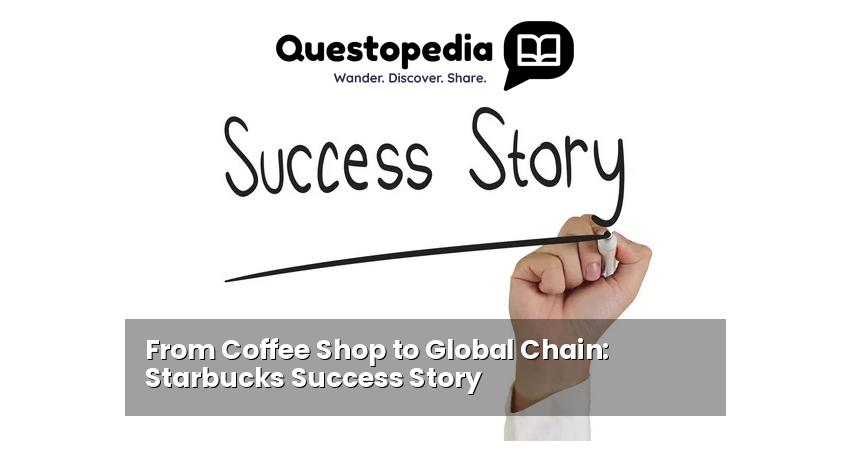From Coffee Shop to Global Chain: Starbucks’ Success Story
Starbucks, a name synonymous with coffee, has become a global phenomenon. But its journey from a single coffee shop in Seattle’s Pike Place Market to a worldwide empire is a fascinating tale of vision, innovation, and a relentless pursuit of customer experience. This article delves into the Starbucks success story, exploring the key strategies that propelled the company to its iconic status.
The Humble Beginnings: A Passion for Coffee
In 1971, Jerry Baldwin, Zev Siegl, and Gordon Bowker, three partners with a shared passion for high-quality coffee beans and equipment, opened the first Starbucks store at 2000 Western Avenue in Seattle. They named it after Starbuck, a character in Herman Melville’s Moby Dick, seeking a name that evoked the romance of the sea and the spirit of adventure. Initially, Starbucks wasn’t about selling brewed coffee; it was about selling whole bean coffee, teas, spices, and coffee-making equipment. They aimed to provide Seattleites with access to the finest coffee beans from around the world. Visit Questopedia for more business success stories.
Howard Schultz and the Italian Inspiration
A pivotal moment arrived in 1982 when Howard Schultz joined Starbucks as the director of retail operations and marketing. In 1983, a trip to Italy opened Schultz’s eyes to the vibrant Italian coffee culture. He observed the social interaction and community centered around the espresso bars in Milan. This inspired him to bring the Italian coffeehouse experience to America. He envisioned Starbucks not just as a place to buy coffee beans, but as a “third place” – a comfortable gathering spot between home and work. This vision was crucial to the Starbucks success story.
Transforming the Business: Brewing the “Third Place” Experience
After facing initial resistance from the original owners, Schultz left Starbucks in 1985 and started his own coffeehouse chain, Il Giornale. In 1987, he acquired Starbucks, merging it with Il Giornale and adopting the Starbucks name. From then on, Schultz’s vision for the “third place” experience became the driving force behind the company’s expansion. This included:
- Creating a Welcoming Atmosphere: Starbucks invested heavily in store design, aiming for a warm, inviting, and consistent experience across all locations.
- Training Baristas: Baristas were not just employees; they were trained to be coffee experts and provide friendly, personalized service.
- Offering a Wide Variety of Beverages: From classic espresso drinks to innovative Frappuccinos, Starbucks catered to diverse tastes.
- Building Community: Starbucks fostered a sense of community by hosting events and providing a space for people to connect.
Strategic Expansion: From Seattle to the World
Starbucks’ expansion strategy was aggressive and well-executed. They focused on opening multiple stores in urban areas, creating a strong brand presence. Key elements of their strategy included:
- Strategic Location Selection: Starbucks meticulously chose locations with high foot traffic and visibility.
- Franchising and Licensing: While they owned most of their stores, they also used franchising and licensing agreements to expand into new markets.
- Global Expansion: Starbucks ventured internationally, adapting its menu and store design to local tastes and preferences. See how Nestle adapted to global markets.
This rapid expansion, coupled with a consistent brand experience, solidified Starbucks’ position as the leading coffee chain in the world. This section really highlights the Starbucks success story as it relates to business strategy.
Innovation and Adaptation: Staying Ahead of the Curve
Starbucks has consistently innovated to maintain its competitive edge. This includes:
- Mobile Ordering and Rewards Program: Starbucks embraced technology to enhance customer convenience and loyalty.
- New Product Development: They constantly introduced new beverages, food items, and merchandise to keep their menu fresh and exciting.
- Ethical Sourcing: Starbucks committed to sourcing coffee beans ethically and sustainably.
- Responding to Changing Trends: They adapted to evolving consumer preferences, such as the growing demand for plant-based milks and cold brew coffee.
Their ability to adapt and innovate is a crucial factor in their continued success. This commitment to future growth proves why the Starbucks success story is worth analyzing.
Challenges and Criticisms: Navigating the Complexities of Success
Starbucks’ success has not been without its challenges. The company has faced criticism regarding:
- Market Saturation: Some argue that Starbucks has over-saturated certain markets, leading to cannibalization of sales.
- Competition: Starbucks faces increasing competition from other coffee chains and independent coffee shops.
- Labor Practices: The company has faced scrutiny regarding its treatment of employees, including issues related to wages and benefits.
Addressing these challenges is essential for Starbucks to maintain its long-term success and reputation.
Conclusion: A Brew of Vision, Execution, and Innovation
The Starbucks success story is a testament to the power of vision, strategic execution, and relentless innovation. From its humble beginnings as a small coffee bean retailer to its current status as a global coffeehouse giant, Starbucks has redefined the way people experience coffee. While challenges remain, its ability to adapt, innovate, and maintain a strong brand identity suggests that Starbucks will continue to be a dominant force in the coffee industry for years to come. The company’s unwavering commitment to customer experience and its ability to create a “third place” for communities around the world have cemented its place in business history.






